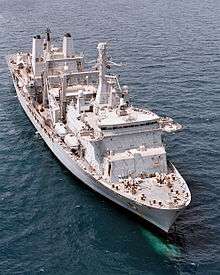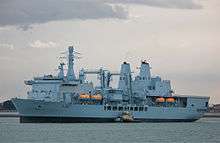RFA Fort Victoria (A387)
 | |
| History | |
|---|---|
| Name: | RFA Fort Victoria |
| Namesake: | Fort Victoria (Isle of Wight) |
| Ordered: | 23 April 1986 |
| Builder: | Harland & Wolff, Belfast, United Kingdom |
| Laid down: | 15 September 1988 |
| Launched: | 4 May 1990 |
| Commissioned: | 24 June 1994 |
| Identification: |
|
| Status: | in active service |
| General characteristics | |
| Class and type: | Fort Victoria-class replenishment oiler |
| Displacement: | 31,565 t (31,066 long tons) full load |
| Length: | 203.9 m (669 ft 0 in) |
| Beam: | 30.4 m (99 ft 9 in) |
| Draught: | 9.7 m (31 ft 10 in) |
| Propulsion: | 2 × Crossley-Pielstick V16 medium speed diesels, 2 shafts, 25,083 bhp (18,704 kW) |
| Speed: | 20 knots (37 km/h) |
| Capacity: |
|
| Complement: |
|
| Armament: |
|
| Aviation facilities: |
|
RFA Fort Victoria is a Fort-class combined fleet stores ship and tanker of the Royal Fleet Auxiliary of the United Kingdom tasked with providing ammunition, fuel, food and other supplies to Royal Navy vessels around the world.
Construction

Fort Victoria was ordered from Harland and Wolff in 1986, and was launched in 1990. She is named after Fort Victoria on the Isle of Wight.[1]
On 6 September 1990, while Fort Victoria was at dock and less than three months after being christened, a Provisional IRA unit planted two explosive devices on board. After a telephone warning from the IRA,[2] one of the bombs exploded, causing extensive damage inside the engine room, which was holed and subsequently flooded. The ship listed 45 degrees, and the chances of sinking were high. The situation was under control after hours of work by emergency teams, which pumped the water out of the engine room. Sir John Parker, the shipbuilder, praised the courage of the engineers for saving the ship. It was not learned that a second device had failed to explode until a second IRA phone call 24 hours later. It took two weeks to find and disable the second bomb, which stalled the works further.[3][4]
This incident and other problems with the construction of the vessel meant it was not delivered until 1993, two years after originally planned.[5] In 1998, the ship was fitted with the Phalanx CIWS.[6]
She was accepted into service on 24 June 1994.
Operational history
The vessel took part in Operation Telic during early 2003.[7]
Fort Victoria was adopted by the Metropolitan Borough of Barnsley and has been affiliated with the borough for over ten years. A battle ensign was presented to the borough in 2003 following the vessel's participation in military operations in the Persian Gulf. The ensign can be seen in the foyer of Barnsley Town Hall.[5]
With her ability to supply anything from humanitarian supplies to fuel and ammunition, Fort Victoria has uses in peacetime and war. An example of this was the 2006 conflict in Lebanon, where she played a key role in supplying the Royal Navy and giving air support with a flight of Merlin MK1 helicopters from 814 squadron.[8]

From November 2008 until May 2009 underwent a refit on the Mersey by Cammell Laird Shiprepairers & Shipbuilders, being towed up from the Solent by tugs Red Dolphin and Englishman. She returned to operational status on November 2009, and was set to rejoin the RFA fleet by the early months of 2010.[9] The ship has undergone another refit from March 2014 to December 2014, The refit included the main engines receiving an overhaul, other machinery, pumps and pipework, new fire-detecting and fire-fighting systems were installed, living quarters refurbished, the weapons and sensors were also completely overhauled, This £50 million refit will allow the ship to serve for at least another 15 years.[10]
Indian Ocean deployments
In September 2010, Fort Victoria was posted to the Indian Ocean as part of Operation Ocean Shield, the NATO mission to combat piracy. She has subsequently been involved in several operations against pirates off the coast of Somalia.[11][12][13] In June 2011 Fort Victoria was deployed off the coast of Yemen with an embarked force of 80 Royal Marines to assist with the possible evacuation of British nationals from that country due to the recent political unrest there. Britain's foreign secretary, William Hague, had advised British nationals to leave the country immediately saying that it was "extremely unlikely" that the UK government would be able to stage an evacuation operation.[14]
On 11 October 2011 Fort Victoria, along with the USS De Wert, was involved in the release of the Italian ship Montecristo after it was hijacked by Somali pirates. The pirates surrendered without resistance.[15] Fort Victoria continued her deployment in the Western Indian Ocean into early 2012. On 12 January she foiled an attempt by pirates to attack cargo ships in the Indian Ocean by forcing a previously hijacked tanker, Liquid Velvet, now being used as a pirate mothership, to return to Somalia.[16] On 13 January 2012, Royal Marines operating from Fort Victoria captured 13 Somali pirates in the Western Indian Ocean after they refused to stop despite warning shots fired from a Royal Navy helicopter. The Commanding Officer of Fort Victoria, Captain Shaun Jones RFA, said:
To manoeuvre such a large ship at speed in close vicinity of a nimble dhow takes extreme concentration and skill; my team were never found wanting. The 13 Somalis certainly found Friday 13th unlucky for them.— Captain Jones, BBC Interview[17]
On 14 May 2012, during its 2012 deployment, U.S. helicopter squadron HSM-77 Detachment Five completed its temporary operational rotation on board the Fort Victoria which was serving as the flagship for Combined Task Force 151. This was the first time that a MH-60R helicopter had ever operated from a Royal Navy ship. The detachment's helicopters primarily concentrated on anti-piracy surveillance missions during this two-week period.[18]
For her four-month-long 2013 deployment, Fort Victoria relieved Wave Ruler and operated with Task Force 53 in the Indian Ocean and Persian Gulf.[19] In September 2013 she took over as flagship of Combined Task Force 151 tackling piracy off Somalia.[20] In mid 2013, she sailed with the COUGAR 13 task group.[21]
Fort Victoria patrolled the Aegean Sea in April 2016, taking over from RFA Mounts Bay.[22]
Notes
- ↑ http://www.royal-navy.mod.uk/operations-and-support/royal-fleet-auxiliary/rfa-flotilla/fleet-replenishment-ships/rfa-fort-victoria/history/index.htm
- ↑ Explosion Rips British Navy Ship in Belfast Reuters, 7 September 1990
- ↑ From an interview to shipbuilder Sir John Parker published by Sunday Times, 13 March 2006: :The contract for Fort Victoria was won, but the ship became a target for the IRA. "She was afloat in the dock when we got the call from the IRA. Later that day the bomb went off and blew a hole in the engine room of the ship. The ship heeled over to about 45 degrees and we thought we were going to lose her. Fortunately some very courageous engineers went on board and lowered pumps in to clear the engine room so we could save the ship." The next day there was a call about a second bomb. It took two weeks to find it and make it safe — valuable time lost. Such incidents moulded Sir John and taught him patience and resolve, the like of which is rare in many boardrooms.
- ↑ IRA bombs British Navy ship An Phoblacht, 13 September 1990
- 1 2 "RFA Fort Victoria". Royal Naval Association. Retrieved 2012-08-10.
- ↑ RFA Fort Victoria features
- ↑ Operation Telic: British Forces Deployed
- ↑ "Evacuation from Lebanon". BBC News. 2006-07-21. Retrieved 2011-02-16.
- ↑ "RFA Fort Victoria Leaves Refit at Liverpool". Royal Navy. Retrieved 2011-02-16.
- ↑ "Victoria is queen of the seas as £50m revamp of Fort-class ship is completed". Royal Navy. 19 December 2014. Retrieved 9 January 2015.
- ↑ "British navy says it forced pirates to row home in shame". The Virginian-Pilot. 2010-10-19. Retrieved 2011-02-16.
- ↑ "British ship seizes pirate vessel in Indian Ocean". BBC News. 2010-11-14. Retrieved 2011-02-16.
- ↑ "RFA Fort Victoria thwarts another pirate attack". Ministry of Defence. 2010-12-01. Retrieved 2011-02-16.
- ↑ "Marines on standby to evacuate Britons in Yemen". The Guardian. London. 2011-06-07.
- ↑ "UK and US forces 'rescue pirate-held Italian ship'". BBC News. 11 October 2011. Retrieved 11 October 2011.
- ↑ "UK Naval Taskforce Foils Pirate Mothership Attack". Royal Navy. 12 January 2012. Retrieved 13 January 2012.
- ↑ "Royal Navy captures 13 Somali pirates". BBC News. 13 January 2012. Retrieved 13 January 2012.
- ↑ Lt. j.g. Adam Arndt, USN (June 8, 2012). "HSM-77 Deploys First MH-60R on British Ship". NNS120608-17. Helicopter Maritime Strike Squadron 77 Public Affairs. Retrieved 2012-06-11.
- ↑ "Different ship, different year as RFA Fort Victoria takes over support mission in the Middle East". Royal Navy. January 11, 2013. Retrieved 2013-02-06.
- ↑ "Royal Navy takes charge of pirate-hunting force". Royal Navy. 10 September 2013. Retrieved 12 September 2013.
- ↑ http://www.royalnavy.mod.uk/The-Fleet/Royal-Fleet-Auxiliary/Stores/RFA-Fort-Victoria
- ↑ "Nato boss: A more fragmented Europe is bad for security". Daily Mail. 14 April 2016. Retrieved 18 April 2016.